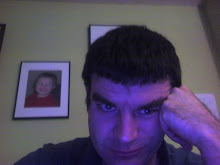The first part of the LCRW reading reminded me a bit too much of a college creative writing workshop. There were a few lines and ideas that made you chuckle, and allowed you to see the potential of the readers, but they just weren't there yet. They said at the start of the reading that there were supposed to be nine (seven?) readers, which made me quail, but I only counted four (six?). If you're questioning my math, since teaching that is my day job, let me explain.
Before the break, the LCRW editor Gavin Grant read a short piece from LCRW about the proper martini. If you've been around the booze block a few times it was the usual story: gin, not vodka; yes, you have to have some vermouth even if it's just on the edge of the glass; the gin doesn't have to be fancy but the vermouth should; an olive or a citrus peel is the proper garnish. Technically I should point out that the classic 'tini features only a citrus peel, and the LCRW gin:vermouth ratio of 6:1 is actually on the light side for the vermouth, the original ration being more in the 4:1 range.
Now I'm off topic. The point was that if you ordered a martini at the bar you would get a free issue of LCRW. This presented a bit of a challenge. I had just finished a Baltika #9, my usual drink at the KGB, which comes out to 1.09 ltr x 8% alcohol = .09 ltr of ethyl. You know what happens when you mix drinks, and I knew that Beefeater and Baltika were just not made to go together. The last time the Brits and the Russkies had a serious interaction was when the UK and US landed troops in northern Russia at the tail end of the Russian revolution, and look how that turned out. To make things worse they didn't have Beefeater, which didn't seem possible. Caution advised against it.
The reading ended with Karen Russell and Jeffrey Ford, both of whom made it worthwhile, but neither of whom, unfortunately, is in the free issue I got. Russell had a great piece about a mergirl and batgirl (get it?), while Ford's piece, which I only vaguely remember (refer back to the Baltika and martini), included an old buy-everything store dragged out of his memory that made me think of Duran's Pharmacy in Albuquerque.
I have more to write but I can't do it, because I have to start a unit on Functions tomorrow, and I haven't even written the lesson plan. More soon, I hope.



